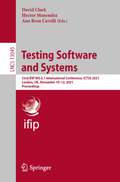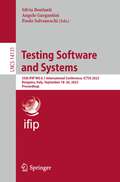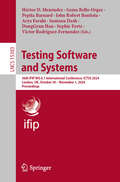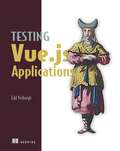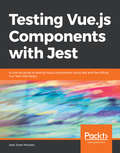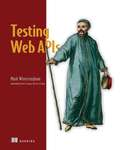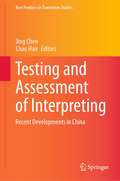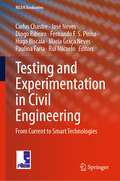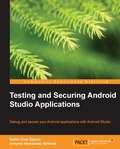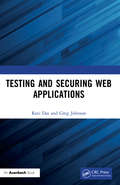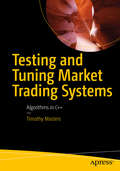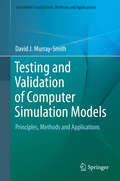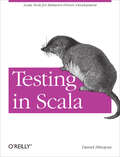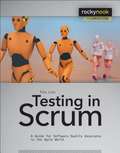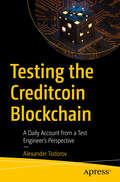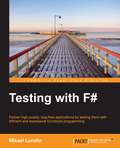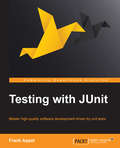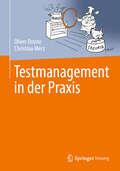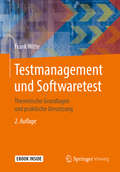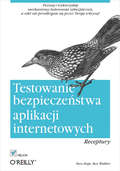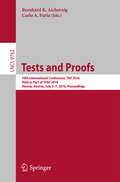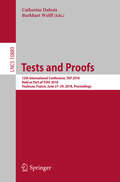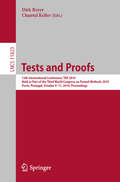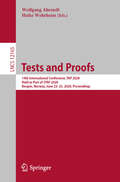- Table View
- List View
Testing Software and Systems: 33rd IFIP WG 6.1 International Conference, ICTSS 2021, London, UK, November 10–12, 2021, Proceedings (Lecture Notes in Computer Science #13045)
by David Clark Ana Rosa Cavalli Hector MenendezThis book constitutes the refereed proceedings of the 33rd IFIP WG 6.1 International Conference on Testing Software and Systems, ICTSS 2021, which was supposed to be held in London, UK, but was held virtually due to the COVID-19 pandemic. The 10 regular papers and 7 short papers presented were carefully reviewed and selected from 36 submissions. Additionally, the volume includes 6 project reports. The papers are divided into the following topical subheadings: Finite State Machine-based Testing; Test Generation and Selection; AI-based Techniques; Use Cases; Project Reports.
Testing Software and Systems: 35th IFIP WG 6.1 International Conference, ICTSS 2023, Bergamo, Italy, September 18–20, 2023, Proceedings (Lecture Notes in Computer Science #14131)
by Angelo Gargantini Silvia Bonfanti Paolo SalvaneschiThis book constitutes the refereed proceedings of the 35th IFIP WG 6.1 International Conference on Testing Software and Systems, ICTSS 2023, held in Bergamo, Italy, during September 18-20, 2023.The 13 full papers presented together with 6 short papers and one journal paper were carefully reviewed and selected from 56 submissions. The conference focuses on Test Case Generation; Test Automation and Design; Model Based Testing; and AI and Smart Contracts Testing.
Testing Software and Systems: 36th IFIP WG 6.1 International Conference, ICTSS 2024, London, UK, October 30 – November 1, 2024, Proceedings (Lecture Notes in Computer Science #15383)
by Héctor D. Menéndez Gema Bello-Orgaz Pepita Barnard John Robert Bautista Arya Farahi Santanu Dash DongGyun Han Sophie Fortz Victor Rodriguez-FernandezThis book constitutes the refereed proceedings of the 36th IFIP WG 6.1 International Conference on Testing Software and Systems, ICTSS 2024, held in London, UK, during October 30–November 1, 2024. The 17 full papers and 5 short papers included in this book were carefully reviewed and selected from 40 submissions. They were organized in topical sections as follows: Best Paper Award; Industry and Challenge Tracks; Mutation Testing and Code Generation; Advancing Code Vulnerability Detection; Short Papers; Tutorial; Journal First; Health Track; Innovations in Software Testing and AI Compliance; Improving Software Testing Reliability and Advancements in Testing Methodologies.
Testing Vue.js Applications
by Edd YerburghSummaryTesting Vue.js Applications is a comprehensive guide to testing Vue components, methods, events, and output. Author Edd Yerburgh, creator of the Vue testing utility, explains the best testing practices in Vue along with an evergreen methodology that applies to any web dev process.Purchase of the print book includes a free eBook in PDF, Kindle, and ePub formats from Manning Publications.About the TechnologyWeb developers who use the Vue framework love its reliability, speed, small footprint, and versatility. Vue's component-based approach and use of DOM methods require you to adapt your app-testing practices. Learning Vue-specific testing tools and strategies will ensure your apps run like they should.About the BookWith Testing Vue.js Applications, you'll discover effective testing methods for Vue applications. You'll enjoy author Edd Yerburgh's engaging style and fun real-world examples as you learn to use the Jest framework to run tests for a Hacker News application built with Vue, Vuex, and Vue Router. This comprehensive guide teaches the best testing practices in Vue along with an evergreen methodology that applies to any web dev process.What's insideUnit tests, snapshot tests, and end-to-end testsWriting unit tests for Vue componentsWriting tests for Vue mixins, Vuex, and Vue RouterAdvanced testing techniques, like mockingAbout the ReaderWritten for Vue developers at any level.About the AuthorEdd Yerburgh is a JavaScript developer and Vue core team member. He's the main author of the Vue Test Utils library and is passionate about open source tooling for testing component-based applications.Table of ContentsIntroduction to testing Vue applicationsCreating your first testTesting rendered component outputTesting component methodsTesting eventsUnderstanding VuexTesting VuexOrganizing tests with factory functionsUnderstanding Vue RouterTesting Vue RouterTesting mixins and filtersWriting snapshot testsTesting server-side renderingWriting end-to-end testsAPPENDIXESA - Setting up your environmentB - Running the production buildC - Exercise answers
Testing Vue.js Components with Jest: A concise guide to testing Vue.js components using Jest and the official Vue Test Utils library
by Alex Jover MoralesUnit test your Vue.js components with this fully-featured JavaScript testing framework Key Features Understand the various testing styles and their purpose Gain insight into how to test methods by avoiding dependencies Explore snapshot testing and its applications Book Description Unit testing in modern component-based JavaScript frameworks is not straightforward. You need a test suite that is reliable and runs quickly. Components are connected to one another, and the browser adds a layer of UI, which makes everything inter-dependent while we test components in isolation. Jest is a fully-featured JavaScript testing framework that will do all your work for you. This book shows you how to test Vue.js components easily and take advantage of the fully-featured Jest testing framework with the aid of practical examples. You'll learn the different testing styles and their structures. You'll also explore how your Vue.js components respond to various tests. You'll see how to apply techniques such as snapshot testing, shallow rendering, module dependency mocking, and module aliasing to make your tests smooth and clean. By the end of this book, you'll know all about testing your components by utilizing the features of Jest. What you will learn Set up a Vue-test project to get started with Jest Unit test your components using techniques such as shallow rendering Gain insights into how to test the reactive parts in the logic of the Vue.js components Explore how to test deeply rendered Vue.js components Perform easy and quick tests with module dependency mocking, module aliasing, and more Know-how and when to use snapshot testing Who this book is for If you are a programmer looking to make your development process smooth and bug-free, this is an ideal book for you. Prior knowledge and experience of JavaScript will help you quickly and easily grasp the concepts explained in this book.
Testing Web APIs
by Mark WinteringhamEnsure your web APIs are consistent and bug-free by implementing an automated testing process.In Testing Web APIs you will: Design and implement a web API testing strategy Set up a test automation suite Learn contract testing with Pact Facilitate collaborative discussions to test web API designs Perform exploratory tests Experiment safely in a downloadable API sandbox environment Testing Web APIs teaches you to plan and implement the perfect testing strategy for your web APIs. In it, you&’ll explore dozens of different testing activities to help you develop a custom testing regime for your projects. This practical book demystifies abstract strategic concepts by applying them to common API testing scenarios, revealing how these complex ideas work in the real world. You&’ll learn to take a risk-driven approach to API testing, and build a strategy that goes beyond the basics of code and requirements coverage. Your whole team will soon be involved in ensuring quality! About the technology Web APIs are the public face of your application, and they need to be perfect. Implementing an automated testing program is the best way to ensure that your web APIs are production ready. About the book Testing Web APIs is a unique and practical guide, from the initial design of your testing suite through techniques for documentation, implementation, and delivery of consistently excellent APIs. You&’ll see a wide range of testing techniques, from exploratory to live testing of production code, and how to save time with automation using industry-standard tools. This book helps take the hassle out of API testing. What's inside Design and implement a web API testing strategy Set up a test automation suite Contract testing with Pact Hands-on practice in the downloadable API sandbox About the reader For dedicated software QA and testers, or experienced developers. Examples in Java. About the author Mark Winteringham is the OpsBoss at Ministry of Testing, where he teaches many aspects of software testing. Table of Contents PART 1 THE VALUE OF WEB API TESTING 1 Why and how we test web APIs 2 Beginning our testing journey 3 Quality and risk PART 2 BEGINNING OUR TEST STRATEGY 4 Testing API designs 5 Exploratory testing APIs 6 Automating web API tests 7 Establishing and implementing a testing strategy PART 3 EXPANDING OUR TEST STRATEGY 8 Advanced web API automation 9 Contract testing 10 Performance testing 11 Security testing 12 Testing in production
Testing and Assessment of Interpreting: Recent Developments in China (New Frontiers in Translation Studies)
by Jing Chen Chao HanThis book highlights reliable, valid and practical testing and assessment of interpreting, presenting important developments in China, where testing and assessment have long been a major concern for interpreting educators and researchers, but have remained largely under-reported. The book not only offers theoretical insights into potential issues and problems undermining interpreting assessment, but also describes useful measurement models to address such concerns. Showcasing the latest Chinese research to create rubrics-referenced rating scales, enhance formative assessment practice, and explore (semi-)automated assessment, the book is a valuable resource for educators, trainers and researchers, enabling to gain a better understanding of interpreting testing and assessment as both a worthwhile endeavor and a promising research area.
Testing and Experimentation in Civil Engineering: From Current to Smart Technologies (RILEM Bookseries #41)
by José Neves Diogo Ribeiro Carlos Chastre Maria Graça Neves Paulina Faria Fernando F. S. Pinho Hugo Biscaia Rui MicaeloThis book gathers the peer-reviewed selected papers presented at the 3rd International Conference on Testing and Experimentation in Civil Engineering (TEST&E 2022), held in Almada, Portugal, on June 21-23, 2022. It showcases the role of smart technologies in all civil engineering areas, such as structures and construction, geotechnics and natural resources, hydraulics and water resources, transportation and communication networks. The conference topics encompass big data and advanced data processing systems, AI applications, virtual and augmented reality, 3D modeling and printing, digital twins, automation, sensing and detection technologies, inspection, monitoring and automatic damage identification, destructive and non-destructive testing, bio, nano and new materials, disaster risk reduction and emergency management. As such the book represents an invaluable, up-to-the-minute tool, and offers an important platform to engineers and architects.
Testing and Securing Android Studio Applications
by Belen Cruz Zapata Antonio Hernandez NinirolaIf you are a developer with some Android knowledge, but you do not know how to test your applications using Android Studio, this book will guide you. It is recommended that you are familiar with Android Studio IDE.
Testing and Securing Web Applications
by Greg Johnson Ravi DasWeb applications occupy a large space within the IT infrastructure of a business or a corporation. They simply just don’t touch a front end or a back end; today’s web apps impact just about every corner of it. Today’s web apps have become complex, which has made them a prime target for sophisticated cyberattacks. As a result, web apps must be literally tested from the inside and out in terms of security before they can be deployed and launched to the public for business transactions to occur. The primary objective of this book is to address those specific areas that require testing before a web app can be considered to be completely secure. The book specifically examines five key areas: Network security: This encompasses the various network components that are involved in order for the end user to access the particular web app from the server where it is stored at to where it is being transmitted to, whether it is a physical computer itself or a wireless device (such as a smartphone). Cryptography: This area includes not only securing the lines of network communications between the server upon which the web app is stored at and from where it is accessed from but also ensuring that all personally identifiable information (PII) that is stored remains in a ciphertext format and that its integrity remains intact while in transmission. Penetration testing: This involves literally breaking apart a Web app from the external environment and going inside of it, in order to discover all weaknesses and vulnerabilities and making sure that they are patched before the actual Web app is launched into a production state of operation. Threat hunting: This uses both skilled analysts and tools on the Web app and supporting infrastructure to continuously monitor the environment to find all security holes and gaps. The Dark Web: This is that part of the Internet that is not openly visible to the public. As its name implies, this is the "sinister" part of the Internet, and in fact, where much of the PII that is hijacked from a web app cyberattack is sold to other cyberattackers in order to launch more covert and damaging threats to a potential victim. Testing and Securing Web Applications breaks down the complexity of web application security testing so this critical part of IT and corporate infrastructure remains safe and in operation.
Testing and Tuning Market Trading Systems: Algorithms in C++
by Timothy MastersBuild, test, and tune financial, insurance or other market trading systems using C++ algorithms and statistics. You’ve had an idea and have done some preliminary experiments, and it looks promising. Where do you go from here? Well, this book discusses and dissects this case study approach. Seemingly good backtest performance isn't enough to justify trading real money. You need to perform rigorous statistical tests of the system's validity. Then, if basic tests confirm the quality of your idea, you need to tune your system, not just for best performance, but also for robust behavior in the face of inevitable market changes. Next, you need to quantify its expected future behavior, assessing how bad its real-life performance might actually be, and whether you can live with that. Finally, you need to find its theoretical performance limits so you know if its actual trades conform to this theoretical expectation, enabling you to dump the system if it does not live up to expectations.This book does not contain any sure-fire, guaranteed-riches trading systems. Those are a dime a dozen... But if you have a trading system, this book will provide you with a set of tools that will help you evaluate the potential value of your system, tweak it to improve its profitability, and monitor its on-going performance to detect deterioration before it fails catastrophically. Any serious market trader would do well to employ the methods described in this book.What You Will LearnSee how the 'spaghetti-on-the-wall' approach to trading system development can be done legitimatelyDetect overfitting early in developmentEstimate the probability that your system's backtest results could have been due to just good luckRegularize a predictive model so it automatically selects an optimal subset of indicator candidatesRapidly find the global optimum for any type of parameterized trading systemAssess the ruggedness of your trading system against market changesEnhance the stationarity and information content of your proprietary indicatorsNest one layer of walkforward analysis inside another layer to account for selection bias in complex trading systemsCompute a lower bound on your system's mean future performanceBound expected periodic returns to detect on-going system deterioration before it becomes severeEstimate the probability of catastrophic drawdown Who This Book Is For Experienced C++ programmers, developers, and software engineers. Prior experience with rigorous statistical procedures to evaluate and maximize the quality of systems is recommended as well.
Testing and Validation of Computer Simulation Models
by David J. Murray-SmithThis must-read text/reference provides a practical guide to processes involved in the development and application of dynamic simulation models, covering a wide range of issues relating to testing, verification and validation. Illustrative example problems in continuous system simulation are presented throughout the book, supported by extended case studies from a number of interdisciplinary applications. Topics and features: provides an emphasis on practical issues of model quality and validation, along with questions concerning the management of simulation models, the use of model libraries, and generic models; contains numerous step-by-step examples; presents detailed case studies, often with accompanying datasets; includes discussion of hybrid models, which involve a combination of continuous system and discrete-event descriptions; examines experimental modeling approaches that involve system identification and parameter estimation; offers supplementary material at an associated website.
Testing in Scala: Scala Tools for Behavior-Driven Development
by Daniel HinojosaIf you build your Scala application through Test-Driven Development, you’ll quickly see the advantages of testing before you write production code. This hands-on book shows you how to create tests with ScalaTest and the Specs2—two of the best testing frameworks available—and how to run your tests in the Simple Build Tool (SBT) designed specifically for Scala projects.By building a sample digital jukebox application, you’ll discover how to isolate your tests from large subsystems and networks with mocking code, and how to use the ScalaCheck library for automated specification-based testing. If you’re familiar with Scala, Ruby, or Python, this book is for you.Get an overview of Test-Driven DevelopmentStart a simple project with SBT and create tests before you write codeDive into SBT’s basic commands, interactive mode, packaging, and historyUse ScalaTest both in the command line and with SBT, and learn how to incorporate JUnit and TestNGWork with the Specs2 framework, including Specification styles, matchers DSLs, and Data TablesUnderstand mocking by using Java frameworks EasyMock and Mockito, and the Scala-only framework ScalaMockAutomate testing by using ScalaCheck to generate fake data
Testing in Scrum
by Tilo LinzThese days, more and more software development projects are being carried out using agile methods like Scrum. Agile software development promises higher software quality, a shorter time to market, and improved focus on customer needs. However, the transition to working within an agile methodology is not easy. Familiar processes and procedures change drastically. Software testing and software quality assurance have a crucial role in ensuring that a software development team, department, or company successfully implements long-term agile development methods and benefits from this framework. This book discusses agile methodology from the perspective of software testing and software quality assurance management. Software development managers, project managers, and quality assurance managers will obtain tips and tricks on how to organize testing and assure quality so that agile projects maintain their impact. Professional certified testers and software quality assurance experts will learn how to work successfully within agile software teams and how best to integrate their expertise. Topics include:Agile methodology and classic process models How to plan an agile project Unit tests and test first approach Integration testing and continuous integration System testing and test nonstop Quality management and quality assurance Also included are five case studies from the manufacturing, online-trade, and software industry as well as test exercises for self-assessment. This book covers the new ISTQB Syllabus for Agile Software Testing and is a relevant resource for all students and trainees worldwide who plan to undertake this ISTQB certification.
Testing the Creditcoin Blockchain: A Daily Account from a Test Engineer's Perspective
by Alexander TodorovFollow the quality engineering journey of the Creditcoin blockchain across four distinct implementation versions and a myriad of technologies. Through the eyes of a test engineer, this book discusses testing implementations with the Hyperledger Sawtooth and Substrate frameworks, testing switch from proof-of-work to proof-of-stake consensus algorithm, and testing an Ethereum Virtual Machine compatibility layer. You’ll traverse several years of fast-paced multiple blockchain implementations and technological changes including an explanation of all major components involved, and the approach taken. You’ll also look at examples of test automation approaches and tools, interesting bugs, and testing challenges. Most everything discussed in Testing the Creditcoin Blockchain is open source, ensuring easy access, and multiple references to source code and GitHub are included throughout. Who This Book Is For Software testers and quality engineers with limited experience working on a blockchain implementation. What You Will Learn Study the many of the components of a distributed blockchain network. See how components work and where testing can be plugged into a distributed blockchain network environment. Glimpse into the daily blockchain testing activities of a principal test engineer. Become familiar with a fast-paced technical software development project.
Testing with F#
by Mikael LundinIf you are a developer who wants to test applications using F#, this is the book for you. Basic experience of testing and intermediate experience of functional programming in F# is expected.
Testing with JUnit
by Frank AppelMaster high quality software development driven by unit tests About This Book * Design and implement robust system components by means of the de facto unit testing standard in Java * Reduce defect rate and maintenance effort, plus simultaneously increase code quality and development pace * Follow a step-by-step tutorial imparting the essential techniques based on real-world scenarios and code walkthroughs Who This Book Is For No matter what your specific background as a Java developer, whether you're simply interested in building up a safety net to reduce regressions of your desktop application or in improving your server-side reliability based on robust and reusable components, unit testing is the way to go. This book provides you with a comprehensive but concise entrance advancing your knowledge step-wise to a professional level. What You Will Learn * Organize your test infrastructure and resources reasonably * Understand and write well structured tests * Decompose your requirements into small and independently testable units * Increase your testing efficiency with on-the-fly generated stand-in components and deal with the particularities of exceptional flow * Employ runners to adjust to specific test demands * Use rules to increase testing safety and reduce boilerplate * Use third party supplements to improve the expressiveness of your verification statements In Detail JUnit has matured to become the most important tool when it comes to automated developer tests in Java. Supported by all IDEs and build systems, it empowers programmers to deliver software features reliably and efficiently. However, writing good unit tests is a skill that needs to be learned; otherwise it's all too easy to end up in gridlocked development due to messed up production and testing code. Acquiring the best practices for unit testing will help you to prevent such problems and lead your projects to success with respect to quality and costs. This book explains JUnit concepts and best practices applied to the test first approach, a foundation for high quality Java components delivered in time and budget. From the beginning you'll be guided continuously through a practically relevant example and pick up background knowledge and development techniques step by step. Starting with the basics of tests organization you'll soon comprehend the necessity of well structured tests and delve into the relationship of requirement decomposition and the many-faceted world of test double usage. In conjunction with third-party tools you'll be trained in writing your tests efficiently, adapt your test case environment to particular demands and increase the expressiveness of your verification statements. Finally, you'll experience continuous integration as the perfect complement to support short feedback cycles and quality related reports for your whole team. The tutorial gives a profound entry point in the essentials of unit testing with JUnit and prepares you for test-related daily work challenges. Style and approach This is an intelligible tutorial based on an ongoing and non-trivial development example. Profound introductions of concepts and techniques are provided stepwise as the programming challenges evolve. This allows you to reproduce and practice the individual skills thoroughly.
Testmanagement in der Praxis
by Oliver Droste Christina MerzDieses Praxisbuch soll ein Handwerkszeug für Testmanager von Software-Implementierungsprojekten sein. Es richtet sich zudem an Projektleiter und alle, die sich mit dem Thema Testmanagement auseinandersetzen wollen oder müssen. Die Autoren haben oft festgestellt, dass in Projekten viele Vorgaben zum Testmanagement existieren, die praxisfern sind und zudem nur mit viel bürokratischem Aufwand umgesetzt werden können. Die Energie wird so oftmals in die Umsetzung eines komplexen Rahmenwerks gesteckt, ohne einen quantifizierbaren Nutzen zu stiften.Hier setzt dieses Buch an. Mit Fokussierung auf das Wesentliche, was für eine erfolgreiche Umsetzung eines Testvorhabens relevant ist, soll es auch als Sparringspartner dienen und dem Testmanager bei seiner Standortbestimmung Hilfe und Unterstützung geben sowie Denkanstöße auslösen.Der Aufbau dieses Buches orientiert sich am Lebenszyklus eines klassischen Projektes (V-Modell / Wasserfall-Modell). Der Praxisbezug wird von den Autoren anhand eines fiktiven Projektes hergestellt, welches mit tatsächlichen Erfahrungen ergänzt wird.
Testmanagement und Softwaretest: Theoretische Grundlagen und praktische Umsetzung
by Frank WitteDas Buch gibt konkrete Tipps zur erfolgreichen Umsetzung von Softwaretests und effizientem Testmanagement. Dabei verbindet der Autor theoretische Grundlagen mit betrieblicher Realität zur Anwendung in der Praxis. Er gibt hilfreiche Hinweise, welche Herausforderungen beim Test von Software bestehen, wo es Fallstricke gibt und was zu beachten ist, um sie zu vermeiden.
Testowanie bezpieczeństwa aplikacji internetowych (in Polish)
by Paco Hope Ben WaltherKsika Testowanie bezpieczestwa aplikacji internetowych. Receptury to napisany zrozumiaym jzykiem podrcznik, dziki ktremu szybko poznasz mechanizmy testowania zabezpiecze.
Tests and Proofs
by Bernhard K. Aichernig Carlo A. FuriaThis book constitutes the refereed proceedings of the 10th International Conference on Tests and Proofs, TAP 2016, held as part of STAF 2016, in Vienna, Austria, in July 2016. The 8 full papers, 2 short papers, and 1 tool demonstration paper presented in this volume were carefully reviewed and selected from 19 submissions. The book also contains one invited talk in full-paper length. The TAP conference promotes research in verification and formal methods that targets the interplay of proofs and testing: the advancement of techniques of each kind and their combination, with the ultimate goal of improving software and system dependability.
Tests and Proofs: 12th International Conference, TAP 2018, Held as Part of STAF 2018, Toulouse, France, June 27-29, 2018, Proceedings (Lecture Notes in Computer Science #10889)
by Catherine Dubois Burkhart WolffThis book constitutes the refereed proceedings of the 12th International Conference on Tests and Proofs, TAP 2018, held as part of STAF 2018, in Toulouse, France, in June 2018. The 8 regular papers, 2 short papers, 1 invited paper and 1 invited tutorial presented in this volume were carefully reviewed and selected from 18 submissions. The TAP conference promotes research in verification and formal methods that targets the interplay of proofs and testing: the advancement of techniques of each kind and their combination, with the ultimate goal of improving software and system dependability.
Tests and Proofs: 13th International Conference, TAP 2019, Held as Part of the Third World Congress on Formal Methods 2019, Porto, Portugal, October 9–11, 2019, Proceedings (Lecture Notes in Computer Science #11823)
by Dirk Beyer Chantal KellerThis book constitutes the refereed proceedings of the 13th International Conference on Tests and Proofs, TAP 2019, held as part of the Third World Congress on Formal Methods 2019, Porto, Portugal, in October 2019. The 10 regular papers and 2 invited paper presented in this volume were carefully reviewed and selected from 19 submissions. The TAP conference promotes research in verification and formal methods that targets the interplay of proofs and testing: the advancement of techniques of each kind and their combination, with the ultimate goal of improving software and system dependability.
Tests and Proofs: 14th International Conference, TAP 2020, Held as Part of STAF 2020, Bergen, Norway, June 22–23, 2020, Proceedings (Lecture Notes in Computer Science #12165)
by Heike Wehrheim Wolfgang AhrendtThis book constitutes the refereed proceedings of the 14th International Conference on Tests and Proofs, TAP 2020, held as part of the 4th World Congress on Formal Methods 2020, Bergen, Norway, in June 2020. The 7 regular papers, 1 short paper and 2 demonstration papers presented in this volume were carefully reviewed and selected from 209 submissions. The TAP conference promotes research in verification and formal methods that targets the interplay of proofs and testing: the advancement of techniques of each kind and their combination, with the ultimate goal of improving software and system dependability.
Tests and Proofs: 15th International Conference, TAP 2021, Held as Part of STAF 2021, Virtual Event, June 21–22, 2021, Proceedings (Lecture Notes in Computer Science #12740)
by Franz Wotawa Frédéric LoulergueThis book constitutes the proceedings of the 15th International Conference on Tests and Proofs, TAP 2021, which was held as part of Software Technologies: Applications and Foundations, STAF 2021, and took place online during June 12-25, 2021.The 6 full papers included in this volume were carefully reviewed and selected from 10 submissions. They were organized in topical sections on learning, test resource allocation and benchmarks and on testing.
